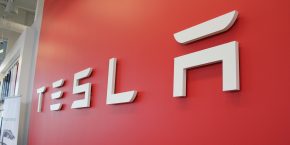

Tesla quietly discontinued the Model S’ 85 kWh battery pack earlier this year and now enthusiasts are anxious to know what the automaker’s next battery upgrade will be .
The company already offers the battery packs with the most energy capacity of any other electric cars on the market, but there’s always room to improve and a cryptic message sent to Elon Musk in the middle of the night last night could give us our best clue to what will be the next improvement to the higher-end version of the Model S.
Earlier this morning, a reader pointed me to a tweet from notorious Model S hacker Jason Hughes.
Hughes is best known among the Tesla community for salvaging two Tesla Model S battery packs in order to create a massive energy storage system for his off-grid residential solar installation even before Tesla introduced its own line of stationary energy storage products.
For one of his latest project, he has been hacking the operating system of a salvaged Model S. He posts tidbit of information he finds out about Tesla and the car on a prolific thread on the Tesla Motors Club (TMC) forums, but this latest information, he decided not to share on TMC and instead sent this tweet to Tesla CEO Elon Musk:
[tweet https://twitter.com/wk057/status/705659185493581824 align=’center’]
I’m not too knowledgeable in cryptographic hash functions myself, but knowing it was coming from Hughes, I had a feeling it would be interesting, and I wasn’t disappointed.
It didn’t take long for TMC members through trials and errors on a hash cracker to find that the decoded value of the original hash string is “P100D”.
It appears that Hughes is hinting that through his hacking of the Model S, he found out that Tesla is working on a 100 kWh battery pack for its performance dual motor Model S.
_______________________
Update: Hughes commented on his find:
“There have been references to the P100D in firmwares as early as 2 months ago. They finally added the badges to 2.13.77.”

If they already have the badge, they must be getting close to release.
_______________________
It would be a significant 11% increase in capacity from the 90 kWh pack introduced by Tesla last year and more than the traditional 8% increase in battery capacity Tesla has been witnessing across the industry every year.
We can’t really translate the increase capacity to range on a full charge without knowing if it is due to energy density improvements or simply being able to add more cells, but the current Model 90D can travel 288 miles on the single charge, while the performance version can reach 270 miles.
If Tesla indeed plans a P100D, it’s not too difficult to imagine them releasing a 100D version also, which could potentially achieve an EPA-rated range of over 300 miles. Presumably, the option would also be available for the Model X, which is currently offered in 70D, 90D and P90D.
Make sure to follow us on Twitter, Facebook or Google+ to get our latest updates on Tesla and electric vehicles.
FTC: We use income earning auto affiliate links. More.




No room for more cells in the pack.
Energy density is constantly improving. This can be done without increasing the number of cells, just as was done when the 85kWh pack was replaced by the 90kWh pack.
That was my point. The article speculates that it may be increased cell count or increased energy density. I’m pointing out that increased cell count is not really possible.
i was wonder what will happen to total engine horsepower and battery power
i suspect engine hp will exceed 800 hp and battery hp will exceed 550 hp easily
and if 300 miles range will combine with that figures than model s p100d (and model x p100d also) then we will have perfect car in every way
Additional cells are not the only way to add capacity.
It might not take more room. A change in chemistry or cell geometry or a combination in the same pack config is totally possible.
“We can’t really translate the increase capacity to range on a full charge without knowing if it is due to energy density improvements or simply being able to add more cells”
Why does it matter? I thought only the capacity of the batteurs mattered, not what it’s due to. If I’m wrong could someone please explain it to me?
We would need to know how the increase in energy capacity affects the weight of the pack, but yeah a roughly 10% increase is safe to assume.
it matters, because the cost of the battery depends on it.
Adding more cells means adding more weight. More charge out of the same number of cells is a much more desirable outcome
That’s going to cannibalise a few sales…
I have a feeling Tesla is pushing the Model S battery capacities up in advance to start making room for Model 3 sizes so they have a nice spread: 60 / 70 for Model 3 and 80 / 100 for Model S
Makes sense…
And next year before Model 3 they will do it again or lower the price of S/X.
Sounds likely. But shouldnt it be more like 50/60 model 3 and 70/100 model s?
I dont think they want to make the base 3 significantly lower range than the base S. It still has to meet supercharger to supercharger comfortably with the AC on with batteries hampered by winter.
Additional cells to the pack would require retooling and new parts design/ development which is expensive mid-production
Most likely chemistry change which is a lot easier to implement
…Could it be improved battery packs/cells coming from the Gigafactory….with the previously noted “moderate” improvement to charge density?
Considering 16 KWh per Km in good climatic condition 20 to 25 0C . 100 KWh will give more than 600 Km [ 360 M ] travel autonomy . If you access to super 120KW charger adding 400 Km in less than 1 hour for à 1000 Km travel the driver will be exauted béfore the car even with auto pilot option